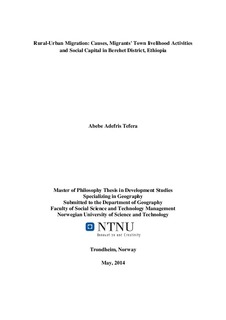| dc.description.abstract | Ranging from the smallest local to the largest international migration is a substance in the process of globalization which drives the present economic, political, social, cultural and technological engines of individuals and groups across various geographic domains in the world. The smallest internal rural to urban migration, which is driven by various factors and ended up with different outcomes in the everyday lives of migrants in towns, is therefore, not isolated from the global process.
Therefore, the aim of this study is to explore the diverse cause to rural- urban migration and migrants' town livelihood activities in Berehet district, Ethiopia which is also thought as the fraction of global process. This study also further focuses on migrants' social capital after migration in the town Metehbila.
With the application of qualitative approach, the study used Lee's push- pull, the new economy of migration theory and the livelihood approach. It is from the ground that theories and approaches are important to visualize the world in every context and hence, they are used in this research to construct and define the research problem itself and to frame the entire process of the researching. Both the migration theories and livelihood approach are used interdependently to understand the various physical and socio-economic causes for rural to urban migration. The Push factors which are mentioned in Lee's migration theory are the vulnerability contexts in livelihood framework and hence, they are used together than independently. The new economy migration theory is used to envisage migration decision, economic causes for migration and the contending issues of internal migration remittance. The livelihood approach is used to frame migrants' urban livelihood activities and strategies that they established to make their living real in the town. It further is used to concretize the social integrations that migrants develop with urban host communities. With the combination of the theories and the livelihood framework components-vulnerability contexts, social capital, strategies and outcome, the analytical framework was developed to entirely shape this study.
With life history mode of analysis and other tabular description approaches of the data which are obtained from primarily and secondary sources, the study found that the causes for rural to urban migration in Berehet district are physical factors such as absence of rainfall, land shortage(also economic) and family death. Socio-economic factors such as forced early marriage, the resulting fistula, conflict with land borders, education and formal marriage. The study in the cloud of socio-cultural factors shows that the district is under increasing human right abuse, abduction, rape and subsequent urban ward migration. It also found that, most of the economic factors are in vision level by migrants. Migrants after their migration are in increasing desire to get better living with better occupations and incomes.
In investigating the urban forms of migrants livelihood strategies, the study shows that most migrants are participating in local drink preparation such as tela and areke selling, retailing onion and potatoes on crowded market. Few migrants are also engaging in wood and welding works, stone cutting and street work/begging. The study generally shows that most migrants in the town established survival livelihood strategies by which they only work to eat and trend the same fashion of living as they were yesterday and decades ago. Contrary to this, few migrants are at the verge to maintain adaptive livelihood strategy by which they relatively could develop better livelihood in the town. Again, the study under investigating the choices of livelihood strategies by migrants, shows that male and female migrants make a stratified working cultural space in the town in which male migrants do not work what women migrants do and the vise versa. It is those male migrants in better off and on the verge to developed sustainable livelihood while women migrants are subjected with indoor activities by which they show no progress in their livelihood in the town.
At the end, the study found that migrants in the town formed various town associations with their town host communities. The associations are Idir, Iqub, Tsiwa and Baltna. The study found that all of these associations are variously important to migrants for securing social capital which serves them to alleviate their everyday town living challenges such death, health shocks and property losses. | nb_NO |
